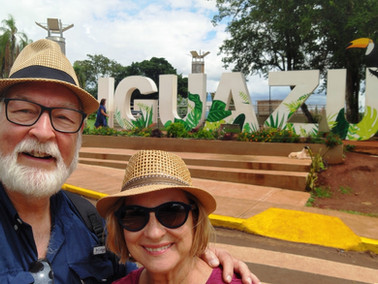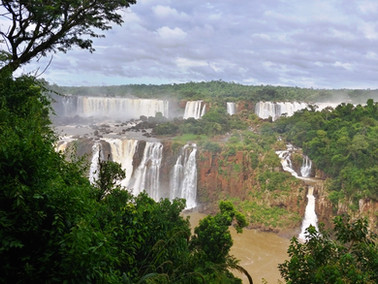Iguazu Falls – “Big Water”…REALLY Big Water!
- pswartz
- Mar 19, 2023
- 3 min read


You may or may not have heard of these waterfalls in South America; but if you’ve ever experienced them, I promise, you will never forget them. These are not like anything you have ever seen.
We spent two days here at the falls, and I recommend no less time here if you plan on visiting. The falls are on the Iguazu River that is the border between Brazil and Argentina and right next to Paraguay. The first day was spent on the Argentinian side and the second on the Brazilian side.

Now throughout this blog, I’m going to do some comparisons to Niagara Falls since many of you have been there and can appreciate the comparison. Trust me, I have nothing against Niagara Falls. It’s a great place to visit and the falls are magnificent, but I have to quote the late U.S. first lady Eleanor Roosevelt when she saw Iguazu Falls for the first time, she said, “Poor Niagara.” She was indeed feeling sorry for Niagara Falls compared to Iguazu Falls. Over all, I’ll have to say that visiting Niagara is Great, but visiting Iguazu is ten times greater!
Let’s start with some basic numbers:
· The quantity of water going over Niagara Falls is a fairly steady 3500 cubic meters per second. Iguazu Falls can be as little as 1500 cu meters in the dry season, but in the wet season (November to March) can reach 13,000 cubic meters per second – that’s enough to fill 5 Olympic swimming pools PER SECOND!
· The tallest of the Iguazu Falls, the Devil’s Throat, drop 262 feet, almost twice the height of Niagara.
· The width of Iguazu Falls is three times that of Niagara – 8800 feet.

But the sheer size of the falls is just the beginning of the experience. When you visit Iguazu Falls, you travel into a rainforest in the middle of the jungle. There are towns nearby, but out at the falls you are surrounded by nothing but nature. By comparison, when you visit Niagara, you have towns on both sides with shops, restaurants and even casinos.

This natural surrounding has over 2000 plant species and all kinds of birds and animals including monkeys, colorful toucans and even five kinds of cats (even jaguars). The Falls became a UNESCO World Heritage Site in 1984 and in 2011, it was a winner of the New Seven Wonders of Nature competition.
If you go to the viewing points for Niagara, you can get good overall views of the falls. But at Iguazu, you have about four miles of trails above, below and mid-level of the falls to get up close to them. It’s very easy to spend a full day hiking all around the falls just on the Argentina side.

Now if you really want to get up close to the falls, at Niagara you can take the boat trip to the falls, and you will experience the power and mist from the falls. At Iguazu, they actually put you UNDER the falls themselves. Not under the heaviest ones as those would just blow you right out of the boat, but under smaller ones and, yes, you will get soaked. (See the pictures)

The second day we spent on the Brazilian side of the falls. Here, you get some very good panoramic views of the falls as well as walking right through the mists created by the 275 waterfalls that make up the system. Yes, 275 waterfalls!
Visiting Iguazu Falls is like nothing else you have ever experienced. The grandeur of nature itself tends to just WOW you, but like our guide said, “take your time and let the waters renew your soul”.

(Click pictures to enlarge and scroll)











































Comments